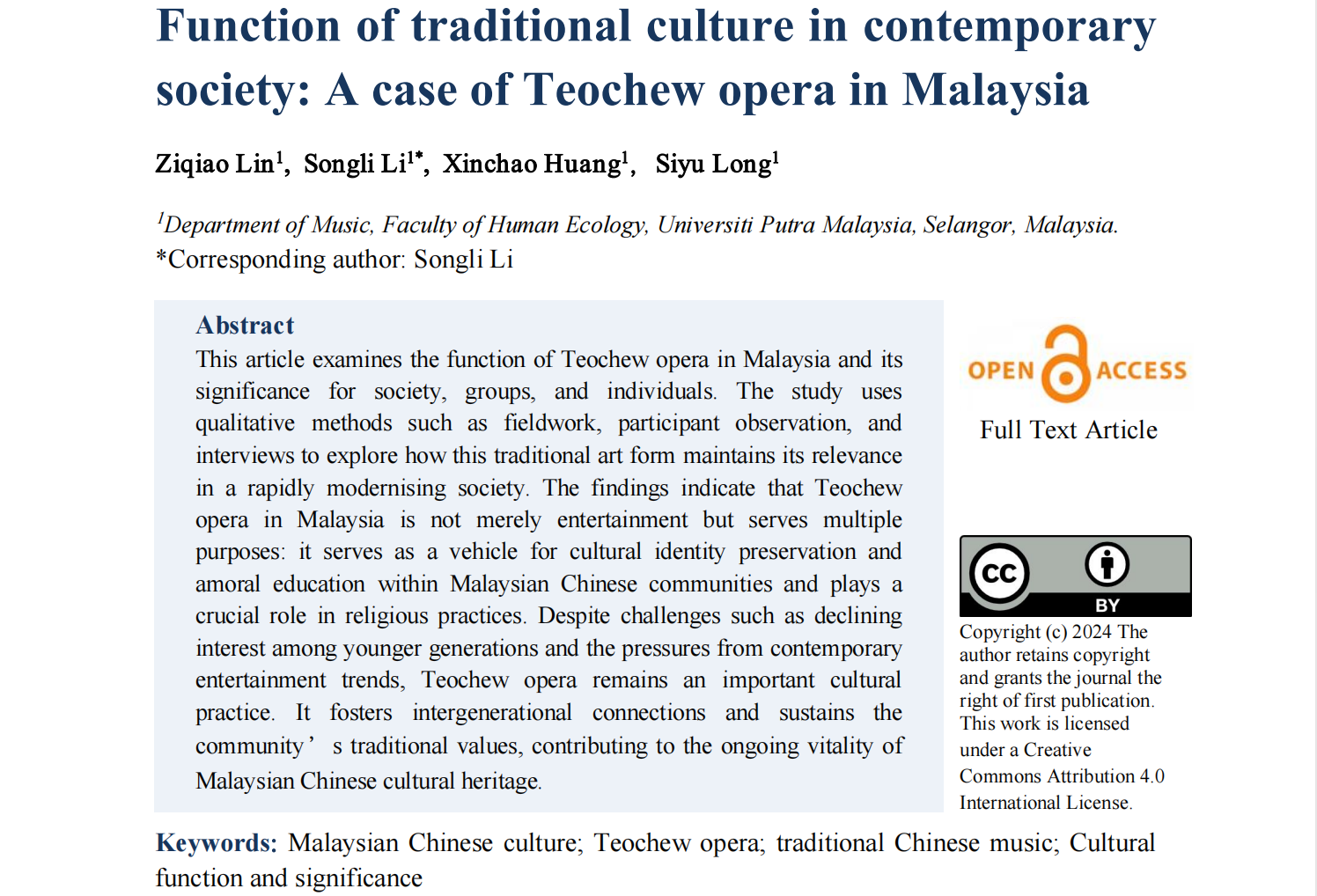Function of traditional culture in contemporary society: A case of Teochew opera in Malaysia
DOI:
https://doi.org/10.5281/zenodo.14224306Keywords:
Malaysian Chinese culture; Teochew opera; traditional Chinese music; Cultural function and significance.Abstract
This article examines the function of Teochew opera in Malaysia and its significance for society, groups, and individuals. The study uses qualitative methods such as fieldwork, participant observation, and interviews to explore how this traditional art form maintains its relevance in a rapidly modernising society. The findings indicate that Teochew opera in Malaysia is not merely entertainment but serves multiple purposes: it serves as a vehicle for cultural identity preservation and amoral education within Malaysian Chinese communities and plays a crucial role in religious practices. Despite challenges such as declining interest among younger generations and the pressures from contemporary entertainment trends, Teochew opera remains an important cultural practice. It fosters intergenerational connections and sustains the community’s traditional values, contributing to the ongoing vitality of Malaysian Chinese cultural heritage.
References
Assmann, J. (2015). Das kulturelle Gedächtnis [Cultural memory]. (Jin, S. F., & Huang, X. C. trans). 北京大学出版社 [Peking University Press].
Ben-Amos, Dan. “Toward a Definition of Folklore in Context.” The Journal of American Folklore 84, no. 331 (1971): 3–15. https://doi.org/10.2307/539729
Halbwachs, M. (2020). On collective memory. University of Chicago press.
Irama, R., & Weintraub, A. N. (2011). Music as a medium for communication, unity, education, and dakwah. In Islam and popular culture in Indonesia and Malaysia (pp. 185–192). Routledge.
Kang, H. L. (2005). 潮剧在马来西亚的流传与发展 [The circulation and development of Teochew opera in Malaysia]. 艺苑 [The Arts], Z(1), 78–85. http://www.cqvip.com/qk/61482x/2005z1/4000353581.html
Lai, B. J. (1993). 东南亚华文戏剧概观 [An overview of Chinese opera in Southeast Asia]. 中国戏剧出版社 [China Theatre Press].
Lin, C. J. (2019). 潮剧见闻录 [Observations recorded of Teochew opera], 暨南大学出版社 [Ji’nan University Press].
Lin, Z. Q. (2023). From sacred to profane: Teochew opera in the Malaysian Chinese community. International Journal of Academic Research in Business and Social Sciences, 13(1), 167–77.
MacMillan, J. (2000). God, theology and music. New Blackfriars, 81(947), 16–26. https://doi.org/10.1111/j.1741-2005.2000.tb07819.x
Maddrell, A. (2013). Living with the deceased: Absence, presence and absence-presence. cultural geographies, 20(4), 501–522. https://doi.org/10.1177/1474474013482806
Merriam, A. P. (1964). The anthropology of music. Northwestern University.
Small, C. (1998). Musicking: The meanings of performing and listening. Wesleyan University Press.
Shi, X. S. (2002). 中国戏曲审美文化论 [On the aesthetic culture of Chinese opera]. 北京广播学院出版社 [Beijing Broadcasting Institute Press].
Wang, F. B. (2001). 二战后东南亚华侨华人认同的变化 [The changes in Chinese identity in Southeast Asia after World War II]. 南洋问题研究 [Studies on the South Seas], (4), 55–66. https://www.cqvip.com/qk/83427x/20014/6681596.html
Wang, G. W. (2006). 宋元戏曲史 [The history of Song and Yuan operas]. 中国书籍出版社 [China Book Press].
Wang, C. (2008). 《礼记· 乐记》与贺拉斯《诗艺》的比较阐释 [A comparative interpretation of Rituals and Music and Horace’s Poetic Art]. 中外文化与文论 [Chinese and Foreign Culture and Literature], (1), 185–193. https://www.cqvip.com/qk/71426x/2008001/690878787200801022.html
Wu, G. Q. & Lin, C. J. (2015). 潮剧史 (上) [A History of Teochew opera (volume 1)].花城出版社 [Hua Cheng Press].
Zhang, Y. P. (2007). 文化权: 自我认同与他者认同的向度 [Cultural rights: dimensions of self-identification and other-identification]. 社会科学文献出版社 [Social Sciences Literature Press].

Downloads
Published
How to Cite
Issue
Section
License
Copyright (c) 2024 Ziqiao Lin, Songli Li, Xinchao Huang, Siyu Long

This work is licensed under a Creative Commons Attribution 4.0 International License.


























